TEXAS
GLORY
AS
HISTORY
- THE
1835 CAMPAIGN
Or, How Austin and Cos Played the Game
By Carl Willner
Or, How Austin and Cos Played the Game
By Carl Willner
This campaign history describes how the historical 1835 campaign of the Texan Revolution, from the weeks of October 7 through December 14 (Turns 1-10), when General Cos surrendered his last garrison at the Alamo and withdrew under parole to Laredo, would have corresponded with the TEXAS GLORY game. The history covers the various actions permitted by the cards, taking into account all movement of land units, including movement by sea, and all battles that occurred during the period of the 1835 campaign of the Texan Revolution. The specific events on the action cards are assigned to a particular turn where a unique event clearly occurred that turn (e.g., Surprise, Deguello). The effects of supply on individual units are not always identified on a turn-by-turn basis, but are discussed in broader terms by turns and over the course of the campaign. It is not always possible to recreate the historical events exactly as they occurred in game terms, given the unavoidable limits of what is possible in a playable game, but the game allows the general course of all the principal events of the campaign to be repeated. Particularly in the 1835 campaign, the revolutionary Texan army was very loosely organized as it was in the process of forming, and the roles of officers shifted over time, so that the individual units represented here for the Texans can only approximate what occurred in real life.
1835 Game Set up. All pictures can be expanded by clicking on them.
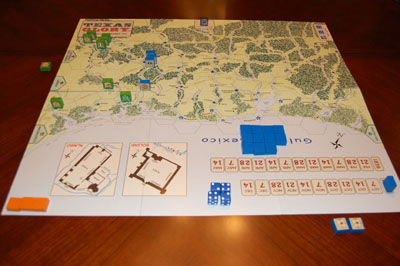
The small navies of Texas and Mexico are not represented by units in the game. Historically, the Texan fleet began forming during this period and there was at least one battle between individual Texan and Mexican warships, on Turn 6 off Matagorda, though no fleet actions. Mostly, the Texan navy was engaged in privateering against Mexican commerce in the Gulf of Mexico, and the Mexican navy was trying to protect its commerce and intercept the Texan “pirates.”
During all turns, there was some movement by the Texan forces, though the Mexicans did not always move, so that it does not appear that the Storm event occurred. Events that can be considered certain or likely to have been played within the context of the “historical” game include Surprise, Runaways, and Deguello. In light of the historical movements, the total types of cards likely used, in game terms, are 2 4 CPs, 6 3 CPs, 6 2 CPs, and 6 1 CPs (including Surprise, Deguello and Runaways). Unused cards include 2 0 CPs (Storm, Comanche), 1 4 CP, 1 2 CP, and 1 1 CP (Local Guide).
During 1835, no towns were burned by either side, even though they could have done so. In game terms, the Mexicans have no incentive to do so in 1835 as long as they have a hope of retaining the Mexican-friendly green towns they hold at the start, reflected in the game by the 1835 victory conditions which require the Mexicans to control at least four unburned towns to win (out of the four green towns in Texas and the three Mexican holding boxes), and also by the ability of the Mexicans in a campaign game to use these towns again as supply sources once recaptured in 1836. In a campaign game, towns burned in 1835 would not have to be retaken by the Mexicans in 1836, but keeping the towns and winning the 1835 portion of the campaign would leave the Mexican with more blocks and better positions at the start of 1836. The Texans might burn green towns to avoid the necessity of leaving garrisons to hold them once captured and eliminate the risk of Mexican recapture in 1835, but this would also deprive the Texans of the ability to use the towns as supply sources in 1835 and as places where Texan reinforcements can be brought in closer to the front once Texan-controlled, rather than in the Texan-friendly blue towns further back. Also, in a campaign game, if the Texans burn green towns in 1835 they simply reduce the number of towns that the Mexicans have to capture from them to win in 1836.
The Battle of Gonzales that began the Texan Revolution, the “Lexington and Concord” of Texas, historically took place just before the start of the first turn of the game, on October 2. In late September 1835, the Mexican commander in Texas at the time, Col. Domingo de Ugartechea, sent a force of 100 dragoons under Lt. Francisco Casteñeda (represented by the Alamo cavalry) to Gonzales, in an effort to recapture a cannon given to the settlers earlier for protection from hostile Comanches. There, the Mexican cavalry skirmished initially with a small body of local militia at the ford, and later on October 2 with a quickly gathered force of 180 Texans, including 50 mounted men (represented by a unit of Texan Militia infantry and the Kimball cavalry). The Mexican cavalry was driven off with few losses on either side – one or two Mexicans killed, and a Texan with a bloody nose due to falling from his horse – and returned to San Antonio.
The campaign begins just as General Martin Perfecto de Cos, who had arrived at Copano on September 20 with the permanente Morelos battalion, has completed his march through Goliad up to San Antonio and assumed command from Col. Ugartechea, who remained as his principal subordinate. Altogether Cos has less than 1000 men under his command, consisting of his one regular battalion and 11 companies of presidial or militia troops, mostly concentrated at San Antonio and the Alamo with two other smaller garrisons at Lipantitlan/San Patricio and Goliad. These Mexican forces are inadequate to repress a rebellion by a Texan population of some 30,000, and Cos adopts a relatively passive strategy of seeking to hold the key strongpoints in the Mexican-populated area of Texas until Santa Anna can send him stronger reinforcements. Historically, the local Tejanos did not play as active a combat role on the Mexican side in 1835 as they did in 1836, as many Tejanos in 1835 still thought they were fighting for their rights under the federalist Mexican constitution of 1824 against an oppressive central government. Some Tejanos sympathized with the central government even in 1835 and spied for Cos, and there were pockets of loyalists, represented in 1835 by Carlos de la Garza and his rancheros, the Garza Tejano unit based at Carlos.
Now that hostilities are inevitable, the Texans have begun to form an army at Gonzales and choose Stephen Austin, the leader of the colony, as their General, despite his lack of military experience (historically, this takes place during the first turn of the game, but Austin appears on the map at the start rather than as a reinforcement to ensure that he is available to the Texans as CinC). Meanwhile, Capt. George Collinsworth’s Texan militia from Matagorda and other places have begun to assemble at Victoria as well, preparing to launch an attack on the weakly garrisoned presidio of Goliad. They are joined on their march to Goliad by the inspiring Ben Milam, who has formerly served in the Mexican army and has just escaped from a Mexican jail.
Turn 1 (October 7) - The Capture of Goliad.
The Texan gains initiative, using a Surprise event giving 1 CP, while the Mexicans also have available 1 CP (but likely not more given their passive opening). Milam moves from Victoria to Goliad before the Mexicans can reinforce the garrison. The Mexicans do not attempt to relieve Goliad with the Lipantitlan cavalry or the Tejanos in range, but merely move the Alamo cavalry from San Antonio to Casablanca to cover Carvajal Crossing, protecting San Antonio from the south. Milam then storms Goliad, and with the benefit of Surprise fires before the Mexican artillery, which would normally go first (A vs. B) can do so. Milam scores two hits on the first round, which with double defense eliminates one step of the Goliad artillery. The artillery surrenders with only one step remaining, and is converted into the corresponding Texan artillery unit. Neither side faces any risk of supply attrition. The Texans receive Horton (1 step) as a reinforcement at Goliad.
In the 1835 scenario, the Horton unit represents Ira Westover’s dragoon cavalry, some 35-40 men. Goliad fell to the Texans on the night of Oct. 9-10, with around 125 Texan militia attacking against a Mexican garrison of some 27 men (and a few others at outposts in the area, but not more than 40-50 total) commanded by Lt. Col. Francisco Sandoval. The battle was over in less than 30 minutes. The Texans had only one man wounded, while the entire Mexican garrison was captured, with a few having been wounded. The Mexican officers were taken to San Felipe and later paroled.
| 1835 Turn 1 Movement | 1835 Turn 1 Battle at Goliad |
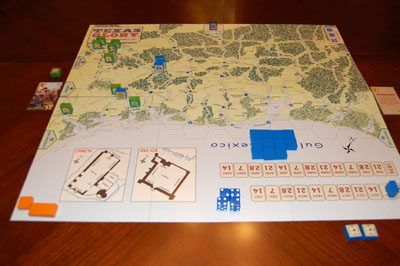 |
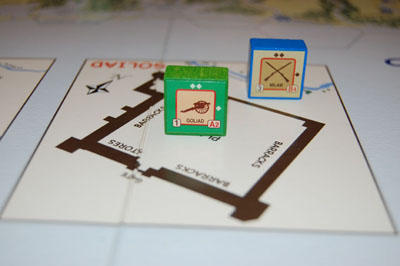 |
| 1835 Turn 1 End | |
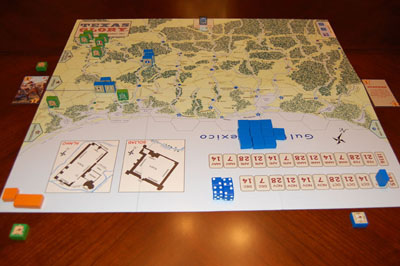 |
Turn 2 (October 14) - Texans Begin Their Advance on San Antonio.
The Texan again gains initiative, with 3 CPs, while the Mexican has available 2 CPs (which end up going unused). The Texans make two moves: 1) Austin is activated and he with his small army, including the Militia infantry and Kimball, advances from Gonzales along the road toward the Alamo and San Antonio, stopping at the river before the Tonkawa Indian village, and Kimball pushes north of the road across the forest hexside, remaining in Austin’s command radius; and 2) Milam moves up from Goliad along the trail to Carvajal Crossing, and crosses the ford to Casablanca. The Texans also forage and gain 1 step added to the Goliad artillery to bring it up to full strength. There is only one potential battle, and the Mexican Alamo cavalry chooses to retreat from Casablanca to the Alamo along the trail in the first round rather than fight Milam, which it can do as both units are Bs. Neither the Texans nor the Mexicans face any risk of supply attrition given their deployments. The Texans receive Seguin (1 step) as a reinforcement at Goliad.
In the 1835 scenario, the Kimball unit represents the mounted Gonzales Lancers (which as their name suggests came from Gonzales, as did Kimball’s company in 1836). The Texans historically left Gonzales on Oct. 12, the end of the previous week, to begin their march to San Antonio. Milam, now formally promoted to Captain (though many of the volunteers recognized him as a Colonel), was commanding a scout company during Austin’s advance to San Antonio when he separately encountered the Mexican cavalry at Cibolo Creek.
| 1835 Turn 2 Movement | 1835 Turn 2 End |
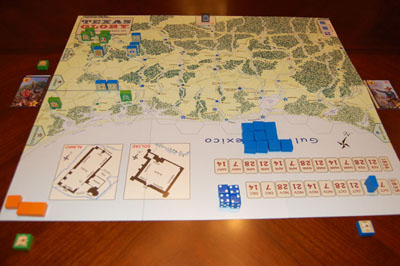 |
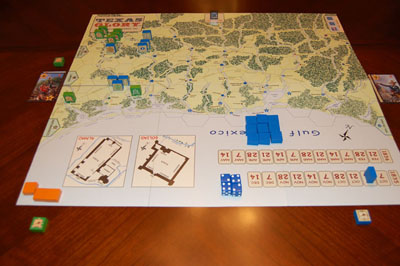 |
Turn 3 (October 21) - Texans Approach San Antonio.
The Texan again gains initiative, with 2 CPs (one of which goes unused), while the Mexican has available 1 CP (which also goes unused). The Texans are not yet prepared to advance to San Antonio and are waiting to build up their army, but they make one individual move: Seguin moves up to Casablanca from Goliad to join Milam. The Mexicans take no action. There are no battles. Neither side faces any supply difficulties. The Texans receive Bowie (2 steps) as a reinforcement at Gonzales.
Historically, Jim Bowie joined the Texan army on October 19, serving as an elected Colonel of the volunteers, and Capt. Juan Seguin soon afterward. The Army of Texas under Austin around this time consisted of 453 men in 11 companies, considerably outnumbered by Cos’s forces in San Antonio and the Alamo.
| 1835 Turn 3 Movement | 1835 Turn 3 End |
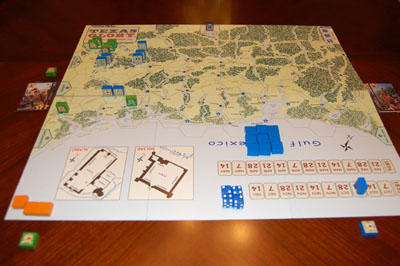 |
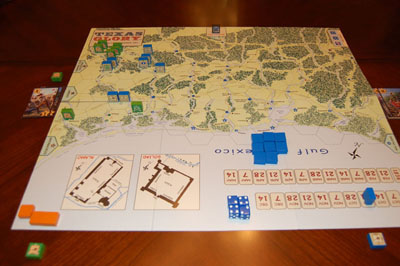 |
Turn 4 (October 28) - The Battle of Concepcion.
The Mexican gains initiative with 3 CPs while the Texan also has available 3 CPs. The Mexicans make three moves: 1) the Lipantitlan cavalry moves up the Atascosito Road to just before Goliad; 2) the Tejanos move from Carlos to Refugio; and 3) the Alamo artillery is shifted from the Alamo into San Antonio. Cos is expecting the Texans to move against the Alamo and San Antonio now, and hopes to distract them with a threat to Goliad, while he already has a strong force of three units assembled at the Alamo, including himself, the Morelos infantry and the Alamo cavalry, leaving the San Antonio presidial troops and the Alamo artillery to garrison the city against any Texan move in that direction. The Texans then make three moves: 1) Austin is activated, and moves with the Militia infantry up to the Alamo, sending Kimball also to the Alamo through the river ford at Comal Springs (making this route of retreat available to the Texans if the upcoming battle goes badly), and bringing Bowie, who was also in Austin’s command radius at Gonzales, up to the Alamo along the road from Gonzales; 2) Seguin makes an individual move up from Casablanca to the Alamo (making this route of retreat also available to the Texans for the upcoming battle); and 3) the Horton unit moves from Goliad around the Mexican cavalry by the trail to San Patricio and enters Lipantitlan. The Texans, with Austin (2 steps), the Militia infantry (2 steps), Bowie (2 steps), Kimball (1 step) and Seguin (1 step), a total of 8 steps, are now confronting a Mexican force consisting of Cos (2 steps), Morelos (4 steps), and the Alamo cavalry (2 steps), also 8 steps. The Alamo artillery, even if kept at the Alamo, would not have been able to participate in the battle fought outside the fort, as the Mexicans initially choose to do in order to try to prevent a siege, nor could the artillery suffer adverse effects from the battle in the open, as artillery in a fort hex is always considered to be defending inside the fort (it could support a Sally from the fort, but the Alamo is not yet besieged). In the first round of the Battle of Concepcion, Seguin fires first (A), followed by the Alamo cavalry and Cos (Bs), then Austin and Kimball (also Bs, but attacking), then Morelos (C) and finally Bowie and the Militia infantry (Cs, attacking). The Texans, remarkably, suffer no losses from the initial round of Mexican fire, while Bowie inflicts a hit on Morelos, bringing the Mexicans down to 7 steps. Though the Mexicans could still decide to defend in the open and hope to prevent a siege, with most of their forces remaining, the Texans have sufficient alternate retreat routes to avoid any loss of units, and the Mexicans are outgunned with Bowie in the field and decide to minimize their own losses. In the second round, the Mexicans retreat, most of their units withdrawing back inside the Alamo while the Alamo cavalry goes to San Antonio, suffering no further losses (only Seguin can fire before any of the Mexicans retreat, and only Austin and Kimball can fire before the Mexican infantry retreats, while Bowie and the Militia have no chance to fire again before the Mexicans escape). The Alamo is besieged, but the Texans choose not to follow up with a storming attack, which would likely suffer heavier losses. The Texans are now at some risk of supply attrition, with 5 units outside the Alamo (2 units above supply limits), while the Mexicans inside the Alamo are not with only 2 units there, nor do they have supply problems with the 3 units in San Antonio. The Texans receive Fannin (2 steps) as a reinforcement at Goliad.
In the 1835 scenario, Capt. James Fannin was serving under Col. Bowie’s command at the battle of Concepcion at this time. The Fannin unit represents the previous Texan garrison commander of Goliad, Capt. Philip Dimmitt, until he is replaced by Fannin during the winter, after Fannin was promoted to Lieutenant Colonel in charge of the Texan “First Artillery” regiment. Lt. William Travis also fought at the Battle of Concepcion as a junior cavalry officer in charge of a mounted company. On October 27 Austin authorized Travis to raise a company of 50 mounted volunteers from the army, and Travis led his first charge after the retreating Mexicans in this battle. The Mexicans suffered by their own admission 48, and more likely 76, killed and wounded at the Battle of Concepcion, along with 1 cannon captured, out of the approximately 400 cavalry and infantry supported by some light artillery that they had engaged, while the Texans lost only 1 man killed and 1 wounded out of Bowie’s force of 92, thanks to the firepower of Bowie’s Kentucky rifles. The quality of the Mexican gunpowder, in contrast, was so poor that Texans reported Mexican bullets bouncing off their bodies. As the rest of Austin’s army came up to reinforce Bowie, who had been in an isolated position at the Concepcion mission, the Mexicans lost heart and retreated, abandoning one of their 4 lb. field pieces to the Texans. After the battle was won in the field, Austin favored an immediate assault on the Mexican positions while the Mexicans were still disorganized, but he was deterred by Bowie and the other officers who reasonably expected that far greater losses would be suffered attacking a fortification supported by artillery. Cos still had at least 650 men available with 12 cannon at this time, even after his battle losses. The Texan provisional government was also formed at this time, meeting on November 3 in San Felipe, and began to form a Texan navy from privateers.
| 1835 Turn 4 Movement | 1835
Turn 4 Battle at the Alamo |
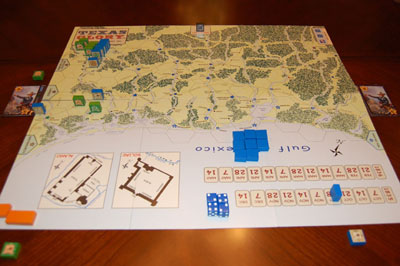 |
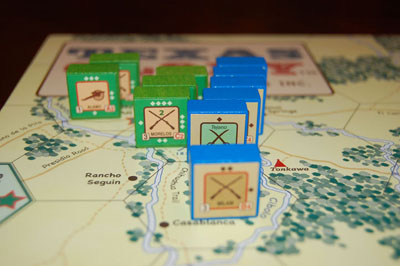 |
| 1835 Turn 4 Ends with Alamo Besieged by Texans | |
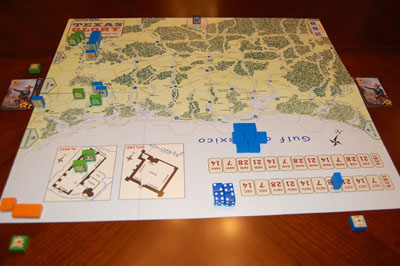 |
Turn 5 (November 7) - Siege of the Alamo Begins, Battle of Nueces Crossing.
This time the Mexicans gain initiative with 2 CPs, while the Texans also have 2 (one of which is unused). The Mexicans decide to abandon the effort to attack Goliad, which is now too well defended with two units inside, and to instead respond to the threat to San Patricio (and possibly even Laredo). The Mexicans make two moves: 1) the Lipantitlan cavalry is pulled back through San Patricio across the crossing of the Nueces to attack the Texans at Lipantitlan; and 2) the Alamo cavalry is moved across the Medina river to Rancho Seguin south of San Antonio to slow any Texan efforts to get around San Antonio for an attack. To reduce supply difficulties, the Texans activate Austin and send Seguin and Kimball on patrol south of the Alamo to Casablanca, while bringing Milam up to the Alamo. In the Battle of Nueces Crossing, both units engaged are Bs, so Horton fires first as the defender followed by Lipantitlan. The Texans score a hit, while suffering no loss, and the reduced Mexican unit retreats back to San Patricio. At the Alamo, the Mexicans initiate a cannonade with Cos (2 steps) firing, to which Austin (2 steps) replies with counterbattery. Neither side suffers any losses. The Texans face some supply difficulties with their main army at the Alamo (1 unit over supply limits), but the Mexicans do not. The Texans receive Travis (1 step) as a reinforcement at Gonzales.
Travis is not yet a brigade leader historically in 1835, but the commander of an independent cavalry force. However, he was an aggressive revolutionary figure from the outset. After the Battle of Concepcion, Travis was sent out on various independent scouting missions with Texan cavalry and Austin made him a Captain. He often worked with Seguin, patrolling to the west of San Antonio to intercept Mexican supplies and reinforcements. Later, on Dec. 20, Travis became a Lieutenant Colonel commanding the Texan Regular Cavalry, and over the winter succeeded to the post of co-commander of the Alamo (along with Bowie, chosen by the volunteers) by default, after the original commander of the Texan garrison, Lt. Col. James Niell, left on leave. The Battle of Nueces Crossing historically took place near the end of the previous week, on Nov. 5, between Westover’s dragoons and the Mexican troops under Capt. Don Nicolas Rodriguez that had formed most of the garrison of Lipantitlan, the 2nd Active Company of Tamaulipas, with 60 Mexican soldados, and 10 Irish irregulars from San Patricio. The Mexicans had lost 27 other men from their company captured by Westover’s men when Lipantitlan was taken, along with 2 guns. At the Battle of Nueces Crossing, Capt. Rodriguez, after realizing that he had been outmaneuvered by Westover, tried to return and recapture his post, but was beaten back with a loss of between 17-42 men killed, wounded and missing, while the Texans suffered only 1 man wounded.
| 1835 Turn 5 Movement | 1835 Turn 5 End |
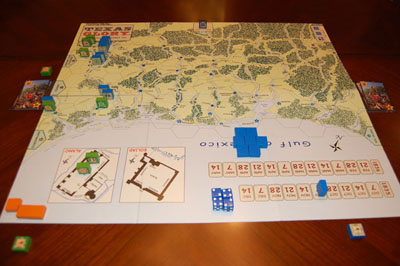 |
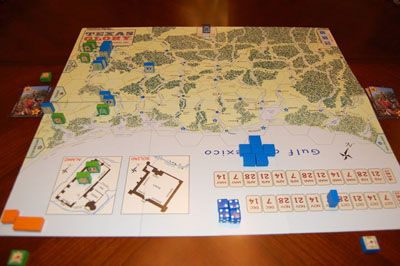 |
Turn 6 (November 14) - Texan Desertions At the Alamo Siege.
The Mexicans use a Runaways event against the Texans’ main army at the Alamo siege, giving them only 1 CP but providing initiative over the Texans, who have 3 CP. The Texans suffer one-step losses in several of their besieging units, including the Militia and Milam. The Mexicans make 1 move: they withdraw their damaged Lipantitlan cavalry back to the safety of Matamoros, planning to rebuild its strength there. The Texans make 3 moves: 1) Travis moves from Gonzales up to the Alamo; 2) Bowie moves from the Alamo down to Casablanca to reduce supply difficulties; and 3) Horton moves from Lipantitlan into San Patricio. At the Alamo, the Mexicans initiate a cannonade with Cos (2 steps) firing, to which Austin (2 steps) replies with counterbattery. Neither side suffers any losses. Indeed, with the Texan desertions, a Mexican sally or attack from San Antonio might have managed to break the siege at this time, but the Mexicans are not confident of their prospects for attacking the Texans after their poor performance at the Battle of Concepcion. The Texans face some supply difficulties with their main army at the Alamo (1 unit over supply limits), but the Mexicans do not. The Texans receive New Orleans (3 steps) as a reinforcement at Linnville.
At this time, historically, the Texan Army under Austin at San Antonio, which had reached a strength of about 700-800 men in early November, was reduced to only a little over 400 men by desertions. By the time of the attack on San Antonio, it had been rebuilt somewhat to 500 men, but never regained its maximum strength. The Texan Army at this stage of the campaign was notoriously ill-disciplined, men coming to join up or leaving the ranks much as they pleased. Boredom and illness were more of a danger to the Texans’ strength in 1835 than were the Mexicans. The New Orleans unit that appears in Nov. 1835, the “New Orleans Greys,” (so named for their obsolete grey U.S. Army uniforms), is really the first of two that fought in the Texan Revolution. The surviving men of this unit historically were incorporated into various other units over the winter, and the second New Orleans unit that appears in Velasco at the start of the 1836 scenario represents further volunteer reinforcements from the same city that arrived in January. Several other interesting events took place at this time. There was a skirmish between a Texan navy ship and a Mexican warship off Matagorda, fighting over the military supplies aboard a beached Texan supply ship. Off-map, the federalist Mexican leader Jose Mexia, allied with the Texans, tried to invade the Mexican port of Tampico south of Matamoros with 150 men, the so-called “Tampico Blues,” but this scheme was defeated by Santa Anna’s centralist forces and many of Mexia’s men were captured and executed, a sign of things to come.
| 1835 Turn 6 Movement | 1835 Turn 6 End |
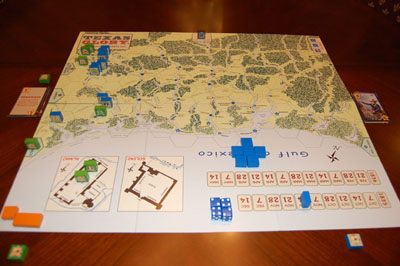 |
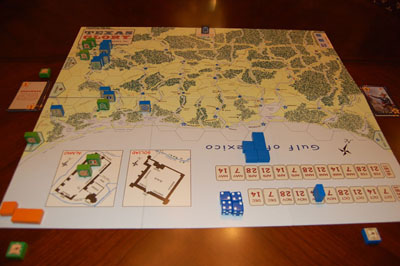 |
Turn 7 (November 21) - The Grass Fight.
The Texans have initiative with 3 CPs, while the Mexicans have only 2 CP. The Texans make 2 moves: 1) New Orleans is moved up to Espiritu Santo from Linnville; 2) Austin is activated and sends Travis, along with Seguin, around to the south of San Antonio below Rancho Seguin to threaten San Antonio from the west (and also possibly Laredo or Presidio Rio Grande), and spread his forces out to reduce supply difficulties (these two cavalry units are the best choice for such an independent mission as they are As and can readily retreat from any attacking Mexican if properly positioned), while also bringing Bowie up from Casablanca through the Alamo (because the Alamo is still under siege Bowie can pass through this hex) and across the ford to Rancho Seguin, and sending Kimball across the ford to Rancho Seguin as well. The Texans also use 1 CP for forage to replace the step loss suffered by Milam. The Mexicans respond by sending the San Antonio infantry to reinforce their Alamo cavalry at Rancho Seguin, and use their remaining 1 CP to provide a step to their Lipantitlan unit by forage. In the Grass Fight that follows, the Mexican Alamo cavalry (B) fires first, followed by Kimball (B, attacking), and then Bowie (C) in the first round, while the Mexican infantry (C), arriving in the second round of combat, would fire after Kimball but before Bowie as a defender. The Texans suffer no losses, while the Mexicans suffer a 1 step loss to their cavalry in the first round, and decide to retreat back to San Antonio in the second round, suffering no further losses. At the Alamo, the Mexicans initiate a cannonade with Cos (2 steps) firing, to which Austin (2 steps) replies with counterbattery. Neither side suffers any losses. The Texans no longer face supply difficulties with their main army outside the Alamo, down to 3 units, nor do the Mexicans. The Texans receive Burleson (3 steps) as a reinforcement at Gonzales.
Discontent with Austin’s leadership style by this point was so great, with Houston intriguing against him back at San Felipe where the Texan provisional government was meeting, that Austin received orders by November 18 relieving him of command and directing him to assume new responsibilities as Texas’s representative to the United States seeking recognition and help, an assignment better suited to his talents. Austin considered an assault on San Antonio before relinquishing his command, but was deterred by Lt. Col. Edward Burleson and the other officers, and he finally left on November 24. After his departure, the Austin block represents a combination of the Texan artillery assembled by that time, and Burleson’s authority as the newly elected CinC. Burleson had been involved with the revolution from the start, and participated in the initial battle of Gonzales as one of the several Texan leaders, but he now assumes command for the first time as the Texans’ elected General (in 1836 he reverts again to a regimental Colonel after Houston takes command). In the Grass Fight, which historically took place on November 26, Bowie with about 140 men including 40 cavalry was sent to intercept a Mexican supply train escorted by cavalry, a total of about 150 defenders initially, which was then reinforced with troops from San Antonio. The Mexicans suffered substantial losses, estimated at 50-60 men including 15 dead left on the field, and the Texans only 5 casualties, including 1 man missing and 4 wounded (one of whom had a headache from a Mexican musket ball that bounced off his head!). The Texans took the train, but they were disappointed to learn it contained not the Mexican army’s paychest, but only “grass,” fodder for the Mexicans’ horses and oxen.
| 1835 Turn 7 Movement | 1835
Turn 7 Battle south of San Antonio |
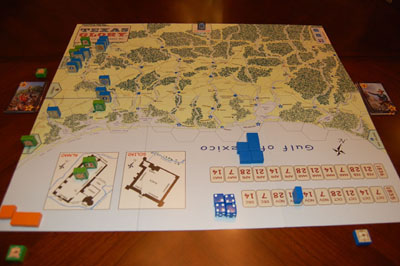 |
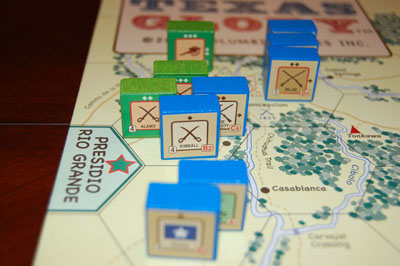 |
| 1835
Turn 7 End |
|
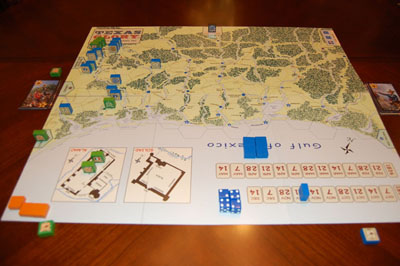 |
Turn 8 (November 28) - The Assault on San Antonio Begins.
The Texans have initiative with 3 CP, while the Mexicans have 1 CP. The Texans make 3 moves: 1) Burleson moves from Gonzales up to the Alamo; 2) New Orleans also moves from Espiritu Santo up to the Alamo, and force marches across the ford into San Antonio; and 3) Austin is activated and sends Bowie and Kimball from Rancho Seguin across the fords of the Medina into San Antonio, while also sending Milam across the ford from the Alamo into Rancho Seguin and from there up to San Antonio, and the Militia across the ford from the Alamo into San Antonio, leaving Austin, along with the newly arrived Burleson, at the Alamo. In the first stage of the Battle of San Antonio, the Mexicans choose to withdraw and defend inside the city, accepting siege, and the Texans storm the city. The Mexican Alamo artillery fires first (A), followed by Milam (B), then the Alamo cavalry (C defending inside a siege, and down a step from the Grass Fight to 1), the San Antonio infantry (C), and then the New Orleans infantry, Bowie, and Militia (Cs, with New Orleans down a step to 2 from force march attrition and the Militia still down a step to 1) and Kimball (also a C storming a city). All 5 Texan units can participate in storming the city as the storming limit is 6 for a city. The Texans have 8 steps attacking against the 7 steps of defending Mexicans.
The Mexicans have double defense fighting inside the city, as do the Texans attacking it. In a two-round battle, the Mexicans lose a step from their artillery and a step from their infantry, while the Texans also lose 2 steps, from Milam and New Orleans. The Texans withdraw as of the third round, maintaining the siege. At the Alamo, the Mexicans initiate a cannonade with Cos (2 steps) firing, to which Austin (2 steps) replies with counterbattery. Neither side suffers any losses. The Texans face supply difficulties at San Antonio, with 5 units there, Austin, Bowie, Milam, New Orleans, and the Militia (3 units over supply limits), but not at the Alamo, with only Austin and Burleson there, and the Mexicans in San Antonio and the Alamo do not have supply difficulties. The Texans receive Grant (2 steps) as a reinforcement at Goliad.
At this time, Burleson nearly abandoned the siege of the Alamo, on December 4 reaching a decision to do so and retreat to winter quarters, which was supported by most of his officers. However, two officers, Milam and Col. Frank Johnson, strongly opposed the decision, and a compromise was reached allowing Milam to ask for volunteers to attack the town. Calling out, “Who will follow old Ben Milam into San Antonio,” he gathered a force of about 300 volunteers for the attack, out of the 500 men remaining in the Texan Army near San Antonio at the time, beginning the attack on the city on December 5. The entry of Texan reinforcements in the late game necessarily accelerates forces that flowed into Texas or assembled during late December and January, for game purposes. For example, Dr. James Grant was involved in the fighting at San Antonio, but after the battle he and Johnson took charge of the so-called “Matamoros Expedition,” an abortive effort to march on Mexico and take the port of Matamoros before the Mexicans could reinforce it. Historically, the governor of Texas issued orders for this expedition on Dec. 17 to Houston, while the governing council ordered Johnson to command it. Grant also declared himself acting commander, and on January 1, 1836 left San Antonio with 200 men heading for Goliad, leaving behind only a small garrison of 120 men under Lt. Col Neill (represented by Bowie and the Alamo artillery after the Texans take control of the Alamo), while Travis, commanding the Texan regular cavalry, returned to San Antonio and added another 30 men to the garrison.
| 1835 Turn 8 Movement | 1835
Turn 8 Battle of San Antonio begins |
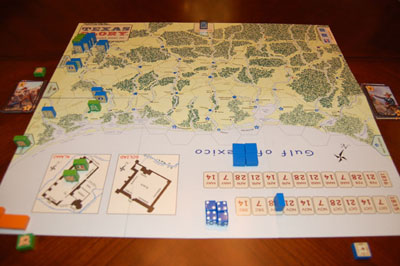 |
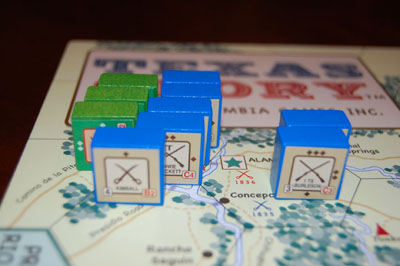 |
| 1835 Turn 8 End | |
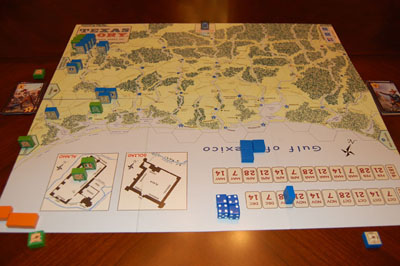 |
Turn 9 (December 7) - The Fall of San Antonio.
The Texans use a Deguello event, giving them only 1 CP but gaining initiative over the Mexicans with 2 CPs (one of which goes unused). The Texans move Grant from Goliad to San Patricio, covering it against any Mexican attempt to reclaim the city. The Mexican Garza Tejano cavalry at Refugio moves back to Carlos, now that the prospects for recovering San Patricio are diminished (in the campaign game, this unit will disband and return with Urrea in 1836 if not killed, and this gets it out of harm’s way by not requiring the Texan to attack it to control Refugio). In the Battle of San Antonio, the Mexicans have 5 steps left, and the Texans 6. The Mexican Alamo artillery again fires first (A), followed by Milam (B), then the Alamo cavalry (fighting as a C inside the city), then the San Antonio infantry (C), and then the New Orleans infantry, Bowie, and Militia (Cs). In a brutal three-round battle, the event card enabling the Texans to attack for more rounds than usual, the 5 remaining steps of the three defending Mexican units are eliminated, except for the last step of the artillery which is captured and converted into a Texan artillery unit after the other Mexicans are eliminated, but the Bowie infantry loses a step (bringing all the Texan units down to 1 step each) and Milam is then eliminated (in game terms, the Texan chooses him to die on the third round to satisfy another pair of hits inflicted by the Mexicans, as he has already fired that round and the Texan wants all of his C units to be able to fire and finish off the Mexicans). The Texans regroup and send the Kimball cavalry back to Rancho Seguin. The Mexicans then sally from the Alamo (the Texan controlled the order of battles so that the attack on San Antonio was resolved first), with Austin (B) firing first, then Cos (also B, but attacking), then Burleson (C), and finally Morelos (C, down a step from losses at the battle of Concepcion to 3). The Texans choose to retreat into San Antonio after a round of battle to join the rest of their army, though suffering no losses. Neither side faces any supply difficulties now, with 6 Texan units in San Antonio and the Mexicans temporarily able to receive reinforcements and supplies from outside the Alamo. The Texans receive Ward (Georgia) as a reinforcement at Linnville.
| 1835 Turn 9 Movement | 1835
Turn 9 Battle of San Antonio continues |
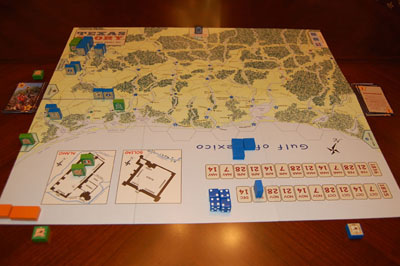 |
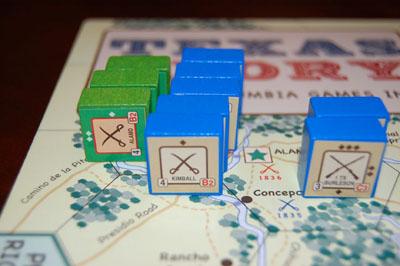 |
| 1835 Turn 9 End | |
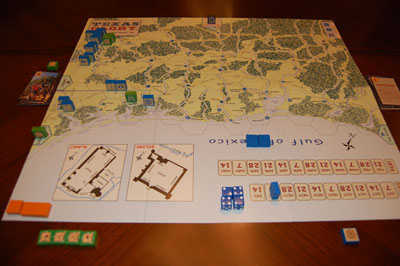 |
Turn 10 (December 14) - End of the Campaign, Cos Surrenders the Alamo.
The Mexicans get initiative with 4 CP, while the Texans also have 4 CPs. The Mexicans choose to forage to rebuild losses to their units in the Alamo (1 step for Morelos, with the other steps going unused) as they do not have a realistic hope of retaking San Antonio, San Patricio or Goliad. In game terms, the inability to use the other steps reflects the uselessness of most of the reinforcements that Ugartechea brought, but getting initiative this turn was key for the Mexicans to be able to forage at all before the Texans returned to resume the siege of the Alamo. The Texans: 1) activate Austin and send most of the Texan forces in San Antonio into the Alamo across the available fords, including Austin, Burleson, New Orleans, and the captured Alamo artillery, leaving Bowie and the Militia in San Antonio, 2) move Travis and Seguin from their position south of Rancho Seguin up to the Alamo by way of Casablanca; 3) move Ward from Linnville to Refugio (force march); and 4) take a step of forage as replacements for a damaged unit at San Antonio (Bowie). The Mexicans could attempt to fight in the open to prevent the Alamo from coming under siege, but the odds are against them, with 6 steps in the Cos and Morelos units against 9 Texan steps that have the edge in fighting quality, so they withdraw inside and accept siege (in a campaign game, this is probably the better strategy as a surrender at the end of the 1835 scenario rather than a last-ditch battle in the open will only cost the Mexicans Cos, who could still appear as a replacement for another leader as he was not killed, but will preserve the more valuable permanente Morelos battalion to return in 1836 as it was also not killed - in the 1835 scenario alone, the Mexican could try his luck fighting outside to prevent a siege of the Alamo, but would likely lose his men as well as the game). The Texans face supply difficulties at the Alamo with 6 units there (3 units above supply limits), though the Mexicans do not. The Texans receive Houston (2 steps) as a reinforcement at San Felipe. The Mexicans surrender the besieged Alamo at the end of Turn 10.
Cos agreed to surrender on December 10, after the fall of San Antonio, and was given a week more for his troops to depart for Mexico under parole not to fight again, actually leaving on Dec. 14. Cos had 1100 men at the time of the surrender with Ugartechea’s reinforcements, but left behind sick and wounded and suffered from attrition marching across the desert, so that by the time his remaining forces reached Laredo on Dec. 25, they were reduced to 800 men. Cos had proudly declined help from the Texans. The 20 guns of the Mexican artillery, including those already captured in the fighting in San Antonio, were of course relinquished to the Texans, apart from one gun Cos was allowed to take for protection against Indians. Santa Anna compelled Cos to break his parole, and he and the permanente Morelos battalion fought again in 1836, though Cos no longer had brigade command. Houston historically became Texan CinC under the authority of the provisional government in late November, though he still did not have command over the main Texan army that had been led by Austin. He did not go to the front in these circumstances, and his authority was not finally confirmed until early March 1836, after the Texan government declared independence from Mexico.
| 1835 Turn 10 Movement | 1835
Turn 10 Texans besiege Alamo again |
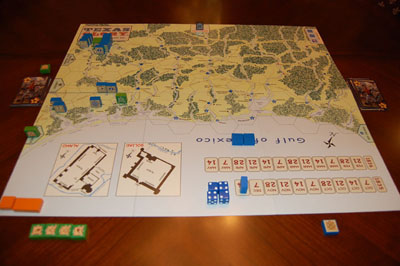 |
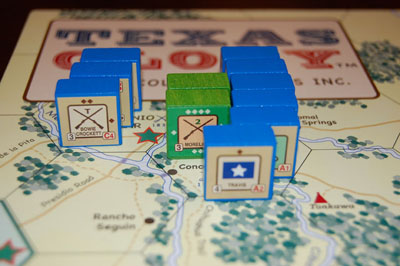 |
| 1835 Turn 10 Cos Surrenders the Alamo | 1835 Turn 10 End game |
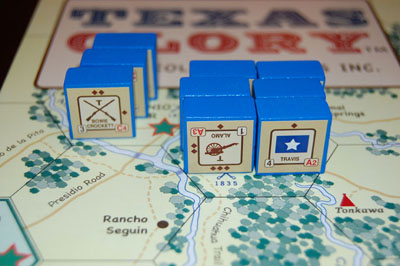 |
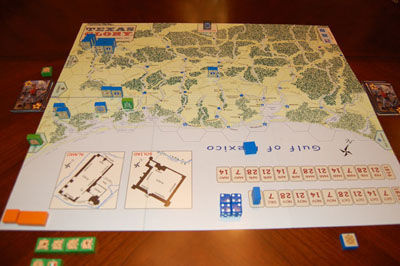 |
The Texans, in control of San Antonio, San Patricio, Goliad, and the Alamo (which comes under their control after the Mexicans surrender the besieged fort at the end of Turn 10 and depart), are the winners, as the Mexicans have failed to hold the minimum of four Mexican-friendly towns they needed to win; they only have the three Mexican holding boxes along the Rio Grande, which the Texans never attacked so that the Presidial garrison troops were never activated. After the end of the campaign, the Texan receives Wallace as a reinforcement at Goliad. Wallace’s Lafayette battalion contained troops from U.S. volunteer units such as the New Orleans Greys, and former Texan members of the Matamoros Expedition who had abandoned it to join Fannin at Goliad. During the winter, there is some reorganization of the Texan army, with new reinforcements arriving from the U.S. and other volunteers and militia going home, to reappear again in the spring when Santa Anna’s army threatened the reconquest of Texas. Davy Crockett arrived in San Antonio from Tennessee with his small band of 13 mounted volunteers in early February, joining with Bowie’s men. Meanwhile, Gen. Sesma’s Vanguard Brigade arrived in Laredo on December 26 to join forces with Cos, later moving up to Presidio Rio Grande to join with the rest of Santa Anna’s forces. From Saltillo in northern Mexico, where Santa Anna’s main army was assembled on January 24, the Mexicans set out in stages across the desert due to the limited supplies, headed for the Rio Grande, while Urrea and his cavalry left Saltillo in another direction, moving down to Matamoros in late January and combining there with the Yucatan battalion before the Matamoros Expedition could get under way from San Patricio, dooming the possibility of an invasion of Mexico. The Texans began to receive reports in mid-January of the advance of Santa Anna’s army, though most still considered a winter campaign across the desert by a large army implausible. Nevertheless, Santa Anna’s soldados made the march, though suffering en route from winter storms and from frequent raids by Comanches on their supplies and stragglers. Finally, on February 16, 1836, Santa Anna with his Vanguard Brigade began its crossing of the Rio Grande and the invasion of Texas was underway.